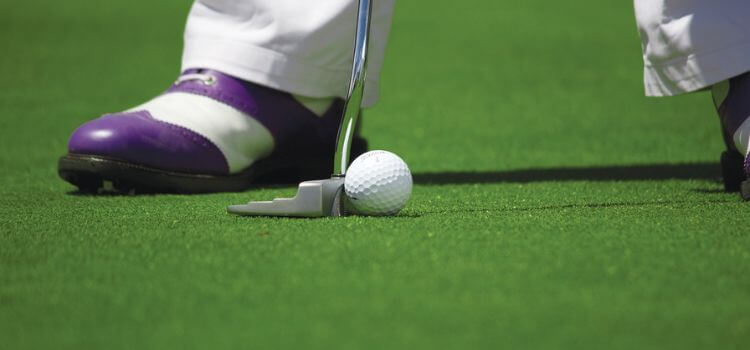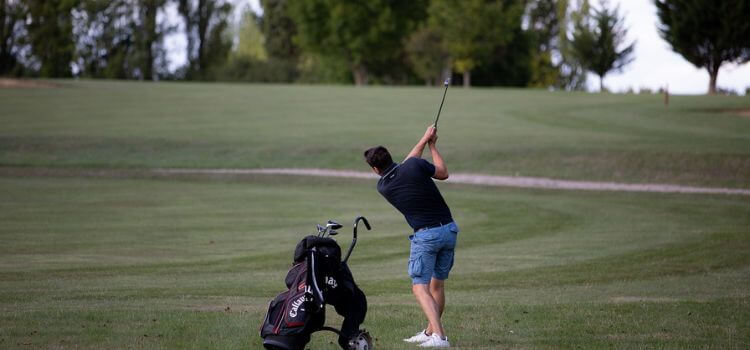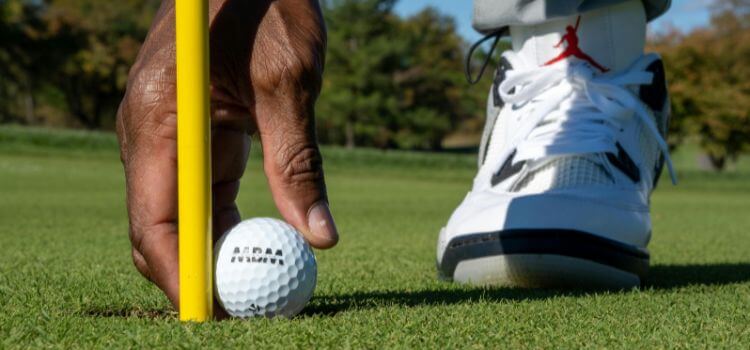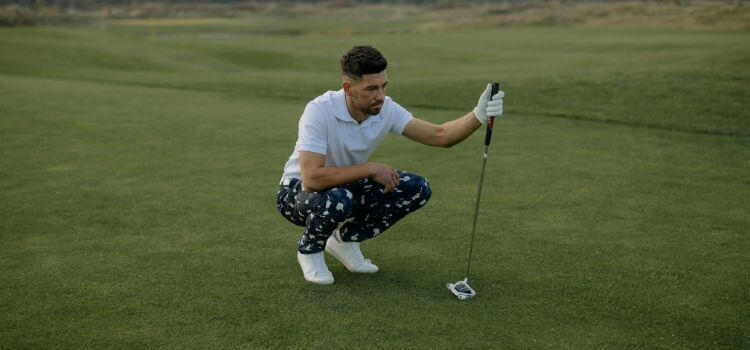Yes, you can wear golf shoes on concrete, but it’s not recommended, as they can damage the spikes. Walking on concrete with golf shoes can also reduce traction and comfort when you return to the grass.
Golf shoes are designed with spikes or nubs on the soles that provide extra grip and stability on the golf course. This design is crucial for golfers as they navigate various terrains during a round of golf and execute their swings.

Wearing these shoes on harder surfaces like concrete can wear down the spikes, affecting their effectiveness and potentially shortening the overall lifespan of the shoes. Additionally, since golf shoes are made for soft terrain, walking on hard surfaces might be less comfortable and can cause unnecessary wear on the shoes that could be avoided with proper use. For these reasons, it’s best to limit the use of golf shoes on the golf course or similar soft surfaces to maintain their integrity and performance.
Introduction To Golf Shoes And Their Purpose
Golf shoes serve a specialized role for golfers. They are not just for style. They improve a player’splayer’s game. Golf shoes provide stability, comfort, and traction, which is important on a golf course. Players must focus on their swing and not worry about slipping.
Design Features Of Golf Shoes
Golf shoes have unique design features. These make them perfect for golf:
- Spikes: Modern shoes have plastic spikes or nubs. These provide grip.
- Materials: They use waterproof materials to keep feet dry.
- Support: The shoes offer arch and ankle support.
- Comfort: Extra padding keeps feet comfortable for long hours.
Benefits of the Golf Course
Golf shoes enhance performance on the course:
| Benefit | Description |
| Stability | They provide a solid foundation during swings. |
| Traction | The spikes ensure players do not slip on wet grass. |
| Flexibility | Shoes flex with the foot’s natural movement. |
| Comfort | Good shoes prevent foot fatigue. |
Distinguishing Golf Shoe Types
Golfers often debate whether they can walk on concrete in their golf shoes. Not all golf shoes are made equally, and the type of shoe impacts comfort and durability. Below, we explore different golf shoe types and their suitability for concrete surfaces.

Spiked Vs. Spikeless Golf Shoes
Spiked golf shoes offer excellent traction on the green, yet they can be harsh on concrete. Over time, walking on hard surfaces wears down the spikes, reducing their effectiveness.
Spikeless golf shoes, on the other hand, feature a flat sole with rubber dimples or nubs. This design means they’re more versatile and comfortable on concrete while still providing adequate grip on the course.
Materials And Durability Considerations
The materials used in golf shoes affect their durability on different terrains. Leather, synthetics, and waterproof materials are commonplace, and each responds differently to concrete.
Leather shoes, while durable, may show wear faster on concrete. Synthetic versions often combine ruggedness with flexibility, making them better suited for mixed-use.
The midsole and outsole construction are also crucial, as they play a key role in the shoe’s overall longevity, especially when regularly encountering concrete surfaces.
Golf Shoes On Concrete Surfaces
Imagine stepping off the green onto a concrete path, your golf shoes clicking with each step. It sounds like golfers know well, but what does it mean for your favorite pair of golf shoes? Here’s the rundown on sporting those cleats on concrete.
Potential Risks To Traction And Sole Integrity
Golf shoes are designed for grass, not concrete. The specialized spikes or nubs on the bottom provide excellent traction on soft, slippery turf. But on concrete, these features face risks:
- Reduced grip: Spikes can wear down, leading to less grip.
- Spike damage: Concrete can break or bend spikes, altering your stance.
- Uneven wear: Spikes might wear unevenly, affecting balance.
- Compromised sole: The integrity of the sole can weaken over time.
Wear And Tear From Hard Surfaces
Concrete Concrete’s hardness is tough on golf shoes.
| Shoe Part | Effect of Concrete |
| Upper Material | Can scuff and scratch against rough surfaces. |
| Midsole | Cushioning may compress prematurely. |
| Outsole | Excessive wear can occur, degrading shoe performance. |
In short, wearing golf shoes on concrete can shorten their lifespan. Always consider your shoes as an investment in your golf game. Walk on soft paths or change into regular shoes to protect them.
Preserving Golf Shoe Longevity
Picture this: impeccably maintained fairways, your best golf shoes, and the perfect swing. Yet, what happens off the green can be just as crucial for your game. A key part of keeping those shoes ready is knowing the dos and don’ts of wearing them on concrete.
Understand that golf shoes are designed for the turf. Venturing onto hard surfaces like concrete rapidly accelerates wear and tear. This section will dive into best practices to ensure your treasured pair remains in top-notch condition for many rounds to come.
Proper Cleaning After Use
Maintaining your golf shoes demands regular care. Here’sHere’s a speedy rundown:
- Remove grass and dirt immediately after a game using a soft brush.
- Wipe the sole with a moist cloth to dislodge embedded debris.
- Use soapy water for a gentle clean on visible stains on the upper part.
- Dry your shoes naturally, avoiding direct heat to prevent damage.
This regimen assists in minimizing damage and preserving both functionality and appearance.
Storing Shoes Correctly
Proper storage is as vital as cleaning. Below lies the blueprint for storing your golf shoes:
- Ensure shoes are fully dry before storing them to avoid mold.
- Use a shoe tree to maintain shape and absorb moisture.
- Store in a cool, dry place away from sunlight.
Following these points will shield your shoes from premature aging and keep them course-ready.
Choosing The Right Shoes For Different Terrains
Knowing which shoes to wear can make all the difference when moving across various terrains. Whether teeing off on the green or walking on concrete, the right footwear is key to comfort and performance.
Comparing Golf Shoes With Walking Or Running Shoes
Golf shoes and walking or running shoes serve different purposes. The cleats or spikes on golf shoes provide stability and grip on grass. Wearing them on concrete may cause discomfort. The spikes can wear down quickly on hard surfaces. Here’s a quick comparison:
| Golf Shoes | Walking/Running Shoes |
| Spikes for grip on grass | Cushioning for shock absorption |
| Not suited for concrete | Flexible soles for pavement |
| Waterproof materials | Breathable designs for airflow |
When To Opt For Cross-trainers
On occasions where you transition from one terrain to another, cross-trainers are beneficial. These shoes balance flexibility, cushioning, and stability. Use cross-trainers for:
- Casual golf rounds without strict dress codes.
- Varied workouts that include different ground surfaces.
- Activities where shoe versatility is crucial.
Tips For Walking On Concrete With Golf Shoes
Golfer or not, knowing how to tread on concrete in your golf shoes helps keep them in top shape. These tips aim to protect the spikes and soles, resulting in a better grip on the green and more durable footwear.

Minimizing Direct Contact With Hard Surfaces
Golf shoes demand extra care of the course. Their spikes aren’t friends with hard surfaces such as concrete. Concrete can dull or even snap the spikes. To lower contact, keep these points in mind:
- Keep walking distances short.
- Find grassy or softer routes.
- Take gentle steps if you must walk on concrete.
Gentle steps lessen the pressure on the spikes, making them last longer.
Using Shoe Covers Or Protectors
Shoe covers act like a shield for golf shoes on concrete. They are easy to slip on and remove. Below are steps to use them:
- Slip on the cover over your golf shoe.
- Make sure it snugly fits over the spikes.
- Walk with ease on any tough surface.
- Remove covers before golfing.
Using protectors can prevent damage and save money on repairs or replacements.
Expert Opinions And Recommendations
When it comes to golf shoes, knowing where to wear them can make them last. Below, experts share their insights. Read on for advice straight from the golf course!

Advice From Golf Professionals
Golf professionals stress the importance of proper shoe care. Here’s what they suggest:
- Save spikes for the greens: Concrete can dull spikes, reducing traction.
- Opt for versatility: Choose shoes with replaceable spikes to switch for various terrains.
- Invest in a second pair: Keep one pair for golfing and another for off-course use.
Experts also recommend cleaning shoes after each use to increase longevity.
Testimonials From Regular Golfers
Golfers share their experiences with golf shoes on concrete:
| Golfer | Experience |
| John Doe | Noticed quicker wear on his spikes after walking on concrete. |
| Jane Smith | Finds soft spikes more forgiving, yet still avoids concrete. |
| Emma Johnson | Uses shoe covers to protect her golf shoes off the course. |
This real-world feedback underlines expert advice – keep those golf shoes on the grass!
Conclusion: Balancing Comfort And Performance
When choosing golf shoes, remember the key is finding a perfect balance. Your shoes should offer comfort and support every step. They must perform well on the course but endure walks on hard surfaces, like concrete, with care.
Summary Of Best Practices
Follow these tips to keep your golf shoes in top shape:
- Pick hybrid shoes if you walk on both grass and concrete regularly.
- Avoid prolonged concrete walks. This can wear down spikes faster.
- Switch shoes post-game to extend their lifespan.
Final Thoughts On Golf Shoe Care
Treat your golf shoes well, and they’ll they’ll treat you well in return. Clean them after each round, store them properly, and monitor their condition. Proper shoe care maintains both their comfort and performance.
Frequently Asked Questions
Can You Walk With Golf Shoes On Concrete?
Yes, you can walk with golf shoes on concrete, but it may wear down the spikes or cleats faster. Opt for shoes with non-metallic, soft spikes to minimize damage and ensure comfort.
Can You Wear Golf Shoes On the Ground?
Yes, you can wear golf shoes on the ground, but only soft-spiked ones to avoid damaging the turf. Check the golf course’s rules, as some may require specific shoe types.
Can You Wear Golf Shoes As Normal Shoes?
Golf shoes are not ideal for regular wear due to their design, which is focused on providing grip during a golf swing. They also might be uncomfortable for everyday activities and can wear out quickly on hard surfaces. It’s best to reserve them for the golf course.
Can Golf Shoes Be Used For Walking?
Golf shoes can be worn for walking, offering stability and comfort. Yet, their spiked soles may only suit some surfaces, and frequent walking can wear them down quickly. Choose spikeless golf shoes for versatile use.
Conclusion
Navigating the pavement in golf shoes isn’t better. Remember, their design suits turf, not the harshness of concrete. Preserve your shoes for the green and switch out before hitting the sidewalks. Golfing footwear is precious—treat it right for lasting comfort and performance on the course.
Keep those spikes pristine!
